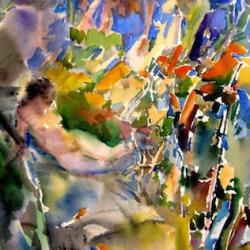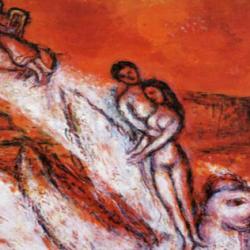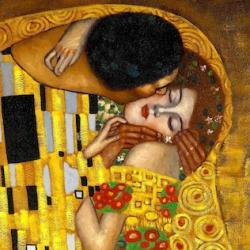Several scholars have written about the interpretation and influence of the Song of Songs during the Middle Ages (Ann Matter, Ann Astell, Denys Turner). So far as I know, no one has done it for the modern world. Edmee Kingsmill’s The Song of Songs and the Eros of God: A Study in Biblical Intertextuality (Oxford Theological Monographs) gives some reason to think that the project is worth pursuing.
Kingsmill suggests that the claim that God created man male and female in his image indicates that “these two aspects represent the one nature of God, inherent in the creation, and manifest at every level from the simplest to the most subtle.” Within Old Testament typology, the male and female principles appear in the figures of the “Friend” and the “Bride.” There’s Jesus the Bridegroom with His Bride, and the Friend, John the Baptist. Or, there’s the bridal exodus story of Ezekiel 16 and the masculine “friend” exodus story that focuses on Israel as Yahweh’s firstborn Son. According to the prophets, Israel as Bride and Friend has failed; as Bride, she has turned harlot, as Friend turned traitor.
Kingsmill goes on to suggest that the history of interpretation of the Song moves from Bridal ascendancy (especially after 1050) to Friend ascendancy (especially after Luther). Luther believes the Song was “an encomium of the political order, which in Solomon’s day flourished in sublime peace,” and incorporated into his commentary on the Song advice to princes coming from contemporary humanists. Luther’s interpretation deletes “all trace of eros, human or divine,” and gives the Song a “dominant masculine” emphasis, “in striking contrast to the Song itself.” Along the way, “the contemplative, intuitive, mystical dimension has been banished and any suggestion of it is encountered with indignation.” Changes in the interpretation of the Song thus provide a new way of examining the controversial question of the relationship of the Reformation and modernity. How does this figure into the rise of rationalism in the 17-18th centuries.
Then there’s pietism, which revives the bridal interpretation, especially through the work of John Cocceius. The Wesleys continued in this tradition. That opens another project: Tracing the ways in which Pietism made the modern world, which, for good and ill, are considerable.
Then music: “Albert Schweitzer, in his great two-volume biography, J. S. Bach , writes that among the hymn-writers of the time were two mystics, Philipp Nicolai and Johann Frank, to whom Bach felt himself particularly drawn, ‘for they, like himself, were steeped in the atmosphere of the Song of Songs.’”
Then there’s Romanticism, especially Herder. And the turn to a non-allegorical sexual interpretation after Renan.
Almost the whole history of modernity could be written as set of variations on the Song of Songs.











